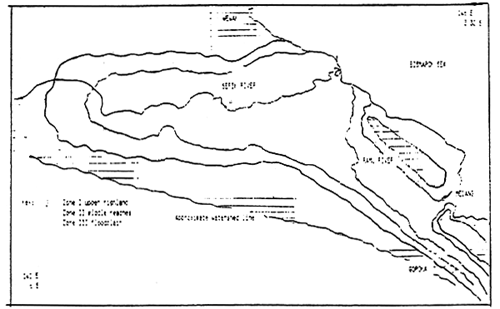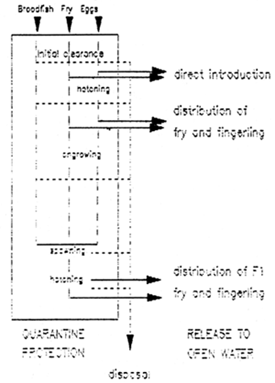Primary work (Coates 1985, 1986, 1987) has established that the Sepik and Ramu river systems of northern Papua New Guinea are low in fish species numbers and biomass by comparison with similar systems elsewhere in the world. Current studies (Coates 1989, 1990) suggest that the system is not food-limited, but that due to its recent zoo-geographical history, there has been limited opportunity for specialised occupation of freshwater niches by suitable species. In the upper Highland reaches of the system there is a particular need for additional quality food sources to serve local populations, many of whom already actively fish the river. In the lower levels, the establishment of a balanced and productive fish stock will have important consequences for the longer-term development of the region.
The UNDP/FAO project PNG/85/001, through which much of the above work has been carried out, has as its main objective the enhancement of fish production in the Sepik system; specific aims of which are:
The main tasks of initial phases of the project have included:
identification of present species and stocks in the Sepik and Ramu river systems;
assessment of current fishing practices, social and other characteristics of people associated with the river system;
identification of possible candidate species for introduction;
the outlining of a protocol and procedure for introducing further species to the river system, including;
the formation of an international Advisory Group to review and recommend on stocking policy and practice.
The project will shortly start its implementation phase, with specific recommendations and action for introduction, transfer, stocking and management of additional species to the Sepik/Ramu system. This report reviews the means for carrying out this work, and comments on the physical and operational requirements and its potential costs. As the total requirements may exceed the scope or budget of the present project, priority areas for the project are defined, and activities have been identified for external funding.
Three major stock introduction zones can at the simplest level be identified (Figure 1):
Zone I; upper highland zones (2000–2500m+), requiring cool temperate species suited to fast flowing streams and rivers, with pools, gravel reaches, rocky stream beds, etc.
Zone II; the middle reaches (500–2000m), requiring warm to cool temperate species, suited to medium-fast flowing intermediate stage streams and rivers, with pools, riffles, etc;
Zone III; the lower floodplain zones (0–500m), requiring warm temperate to tropical species, suitable for slower flowing river, floodplain and temporary lake conditions;
Figure 1 Location/main river zones of the Sepik/Ramu system

In the lower reaches of the rivers, the main habitats/feeding niches to be occupied include; seasonal occupation of possibly low-oxygen floodplain zones, benthic/mud detritus feeding, specialised phytoplakton feeding, macrophyte, fruit and leaf feeding. In the middle and upper reaches, litter, drift material, insect larvae, smaller fish and benthic and lithophytic material's constitute the main food resources; as very few species are currently present, almost any reasonably versatile and exploitable species might be considered.
Populations should preferably become self-sustaining within a reasonably short time. or be dependent on only minimal levels of continued restocking. The only exception might be if a species was of uncertain potential or risk. Where a non-supporting population would be preferred, at least for initial test transfers.
The main species for introduction/transfer to the system have been discussed and reviewed eg by Coates, 1986, 1987 and Welcomme, 1989, subject to further review and approval by the Advisory Group and the PNG authorities. Possible species might include (but need not be confined to) the following:
Zone I
Tor spp. - ‘mahseer’; N.Indian/Himalayan cold water species: specific strains would have to be selected; some aquaculture experience.
Zone I/II
Salmo gairdnerii - stocks already in PNG, but alternate strains, eg with different spawning characteristics, body form, etc may improve potential; extensive aquaculture experience, wide range of stock sources.
Schizothorax spp. - Himalayan snow trout, species/ stocks would need to be selected carefully; these may be particularly interesting for highland areas; limited, experimental aquaculture experience.
Zone II
Acrossocheilus spp - Himalayan cyprinid; limited aquaculture experience.
Leptobarbus spp. - carp species: some aquaculture experience.
Labeo rohita - Indian carp, ‘rohu’; widespread aquaculture experience.
Prochilodus (probably platensis) - fine detritus feeder; from Latin America; strain needs to be selected carefully; should migrate along lower areas; experimental aquaculture experience.
Misgurnus anguillicaudatus - for swampier deoxygenated areas; some holding experience of related species.
Puntius gonionotus - versatile cyprinid for lower waters; would need to be imported; aquaculture experience.
Zone II/III
Cyprinus carpio - common carp; already in the system; better strains may be available; extensive culture experience; wide range of stock sources.
Zone III
Osphronemus gorami - for fruit and higher vegetation: deoxygenated waters; already in the P.Moresby area; some aquaculture experience.
Trichogaster pectoralis - epiphyte and zooplankton feeding; deoxygenated waters; already in Southern PNG; some aquaculture experience.
Oreochromis mossambicus - tilapia; already in the system; phytoplankton/omnivore; better more productive strains may be available; it may also be useful to widen the present genetic base; extensive aquaculture experience.
Nematolosa sp - detritus and algal feeder, native to Southern rivers of PNG.
Anabas testudineus - insectivore; suitable for deoxygenated areas; already established in Irian Jaya and has spread to Fly River, Southern PNG; aquaculture experience.
Tilapia rendalli - stocks to be determined; for exploiting higher vegetation; would have to be introduced into PNG; some aquaculture experience.
Colossoma or Mylossoma spp - fruit/allochthonous plant feeding; Latin American warm water riverine species, tolerant of low oxygen levels; some aquaculture experience.
Those species for which there is some aquaculture experience may be more immediately feasible for introduction, as such experience has direct bearing on the ease of eg handling, quarantining, broodstock holding, spawning and fry rearing, and may also determine the availability of stocks of known characteristics.
The most immediate social and developmental priority is that of stocking the upland waters (Zone I and II), to provide additional food supply to the populous areas of the Papua New Guinean Highlands. Precisely because of their geographical characteristics - located on the higher altitude low-order streams and rivers in dispersed and often poorly accessible areas - these will be the most difficult for distribution and establishment of stock. By contrast, the lower lying zones are relatively accessible, and offer a fairly continuous habitat in which introduced stock might be expected to disperse by itself.
Because of the importance of the Sepik-Ramu system, and because of its unique biological characteristics, transfers and introductions should be carried out in the most scrupulous manner practically possible. The guidelines offered by the EIFAC/ICES Codes of Practice (Turner, 1988) would form the basis of the intended protocol and procedure.
A careful and intelligent approach to risk/benefit assessment would be required at all stages, to ensure that a reasonable balance is found between ‘idealist’ theoretical constraints and practical feasibility. A well balanced, practical and operational programme is likely to be a better protection for the system than an excessively conservative regime which would encourage illegal and uncontrolled introductions by other means.
Figure 2 outlines the main procedures involved: the system would comprise an initial holding/ quarantine stage, followed either by direct introduction to the intended locations, or more commonly by transfer of eggs to intermediate centres, for fry hatching and distribution, or in some cases, for growing broodstock to produce F1 stock for distribution.
Figure 2 Outline of Quarantine Procedures

Where particular protection is required, it may be necessary to raise broodstock through quarantine and release F1 eggs for rearing as potential broodstock, thus waiting until F2 generation for introduced stock. Where stock are transferred from other water bodies in PNG, quarantine may not be so rigorous, though some inspection is desirable.